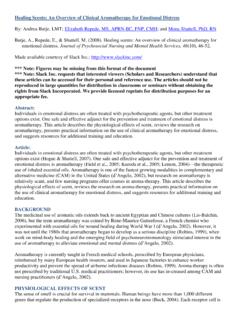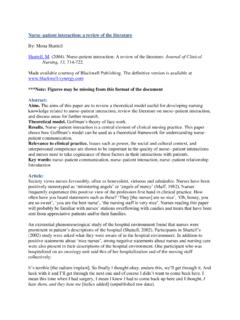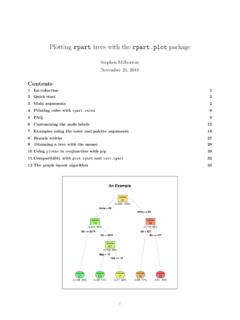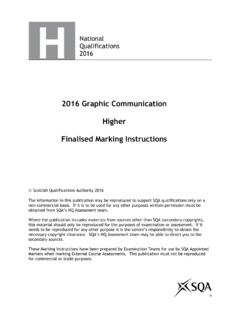Transcription of The Use of Masks in Counseling: Creating Reflective ... - …
1 The Use of Masks in counseling : Creating Reflective Space By: Heather C. Trepal-Wollenzier and Kelly L. Wester Trepal-Wollenzier, H. C., & Wester, K. L. (2002). The use of Masks in counseling : Creating Reflective space. Journal of Clinical Activities, Assignments & Handouts in Psychotherapy Practice, 2(2), 123-130. Made available courtesy of Taylor and Francis: **Reprinted with permission. No further reproduction is authorized without written permission from Taylor and Francis. This version of the document is not the version of record. Figures and/or pictures may be missing from this format of the document.** Abstract: Using expressive art techniques in counseling is one way in which to open space for a client to reflect on his or her concerns or problems in therapy. One form of expressive art is the use of Masks . Masks have been used throughout history in theatre and counseling .
2 In therapy, Masks have been used as projective tools for clients to reflect their experiences onto. This article discusses one client's experience in Creating a mask while working on her issues as a survivor of sexual abuse. In addition, recommendations are discussed for using Masks with different populations. KEYWORDS: Masks , expressive arts, sexual abuse, Reflective thinking Article: Most therapists are trained, and utilize, traditional talk-therapy; however, there are other aspects of therapy that are creative, but tend to be ignored. Creative forms of counseling can include the use of metaphors, music, expressive arts, bibliotherapy, and dance. According to Gladding (1998) " counseling is a creative process that focuses on helping clients make appropriate choices and changes" (p. ix). Through counseling , therapists have found that one technique or method does not always work for every client, and that sometimes creativity is required.
3 There are times when a therapist may reach an impasse with a client who either does not want to talk or cannot verbalize their experience. In other situations, a therapist may encounter children, adolescents, and even adults who may be at different developmental stages and are unable to didactically discuss their concerns. What could be seen as a crisis, failure, or resistance from the client, can become an opportunity for both the client and the therapist to use creative interventions that creates space for the client to begin working on those experiences. Some traumatic events which may lend themselves through creative interventions include domestic violence, grief, exposure to violence, terminal illness, or clients experiencing symptoms of post-traumatic stress. Art is one creative way in which a client can experience their situation or the world around them.
4 Expressive art can help clients, and the counselor, gain a unique perspective on problems and possibilities. Creative or expressive art techniques can enable a client to recognize their multiple natures, as well as allow and encourage nonverbal clients to participate meaningfully in counseling relationships (Gladding, 1998). An example would be a client who is unable to identify and verbalize any emotions, but can express them through the use of paints and color. This use of color allows the client to identify his feelings and engage in a conversation about them with the therapist. People who have been victimized or may be unable to verbally convey the events they have experienced (Gladding, 1998) may also benefit from expressive art techniques. Hargrave-Nykaza & Watertown (1994) point out that art is helpful and valuable to rape survivors because victims of psychological trauma have difficulty expressing their experiences directly and effectively through words.
5 Art allows the rape survivor to relive and explore experiences and issues in a nonverbal way that is less threatening than traditional talk therapy (Backos & Pagon, 1999). Creative interventions ( , art) allow a client time and space to silently reflect, project, and explore. Allowing tune for private exploration of thoughts and feelings before risking disclosure is especially important for survivors of sexual trauma (Backos & pagon, 1999). THE USE OF Masks IN THERAPY One form of expressive art is the use of Masks in therapy and treatment A mask can be seen as a psychotherapeutic tool which is .. very ancient and very new (Janzing, 1998. p. 156). There are obvious implications with Masks used in theatre. hut Masks certainly take on a creative and expressive life of their own when working with clients. Various counselors have sought to use Masks in order to assist clients in gaining distance from their problems.
6 Once this distance has been created, clients are given space to be Reflective (West, Watts, Trepal, Wester, & Lewis, 2001). Landy (1986) notes four ways in which a mask can be used in counseling : (a) to represent two sides of a conflict or dilemma, (b) to express one's identity in a group, (c) to explore dreams and imagery, or (d) to express a social role. In therapy, the mask i:s an image of the self (Fryrear & Stephens, 1988). For example, to express one's identity in a group, the therapist can ask a client to design a mask to express his or her perceived role arid desired role in the family. This may allow the client to externalize the differences between the role that is currently held versus the role that he or she would like to hold in the family. Thus, removing the conflict from themselves and Creating room to change. An example of a second way a mask can be used in counseling is to explore dreams and imagery.
7 If a rape survivor entered therapy discussing a nightmare, the therapist could have the client design a mask representing a conflictual part of their dream. The mask allows the client to externalize the conflictual part of the dream, thus assuming power. Once the mask is complete, the client will be empowered to rewrite the ending to their dream. The mask allows the client to externalize a concern or part of their self. This part of the self is a persona of the clknt that is not overtly expressed. Landy (1985) states, In therapeutic mask work, then, the mask is used as a projective technique to separate one part of the self from another. The masked part, the persona, being stylized and dramatic, provides a measure of distance from the person. Through the work with the persona, the person comes to see his dilemma more dearly. The therapeutic masquerade or drama of Masks aims to unmask the self through masking a part of the self that has been repressed or seen dimly by the client (p.)
8 51). This projective technique is one that allows space for the client to reflect on the concern or issue they have brought into the session. Having a client create a mask and then asking them to write to, or dialogue with, this mask allows for this opening of space, thus allowing oneself to be removed from the immediate situation and to be put into a Reflective position. Masks have been found to be beneficial when used in healing rituals (Fryrear & Stephens, 1988; Hinz & Ragsdell, 1990). They have also been found to be helpful with clients suffering from bulimia (Hinz & Ragsdell, 1990), victims of trauma, or as you will see in this article, survivors of sexual assault or rape. CLINICAL INTERVENTION VIGNETTE As a doctoral student in a counseling and Human Development program I never received much training in using expressive arts and art materials in counseling sessions.
9 When I began a job as a counselor in a rape crisis program I discovered that an art therapist had used my office before I was there and had left an abundant supply of artistic materials. I fumbled through boxes filled with neon colored glue, buttons, Masks , bells, acrylic paints, felt, paper materials of various sizes and shapes, and cardboard boxes . My first few days in the office I bundled all of the supplies up and placed them neatly on the shelves replacing them with my books on clinical interventions, feminist theory, trauma, and anxiety. As my caseload began to fill I was inundated with survivors of rape and sexual assault of all ages. These were individuals who had lived through trauma and were still dealing with the scars. I delved into information on dissociation, coping skills of rape survivors, sexual healing, and boundaries. During one session, a female survivor of childhood sexual abuse related a story in which she expressed feeling as though she were wearing a mask.
10 Her words struck me like a lightening bolt and I felt a rush of excitement as I remembered the paper Masks that I had stored away on my shelf. Bravely, I asked my client if she would be willing to attempt an artistic intervention, although we would not be focusing on artistic skills, but instead on the process involved in the art making. She agreed to try and we set an appointment for the following week. Realizing that I was not trained as an art therapist, I sought consultation from the center's director (a registered master's level art therapist) on working with clients and the expressive arts. She helped me to capture my creativity and educated me to focus on the process that the client is involved in Creating the art. We discussed the use of art medium various textures and materials might evoke certain reactions from clients who have experienced trauma such as rape or sexual assault.
















